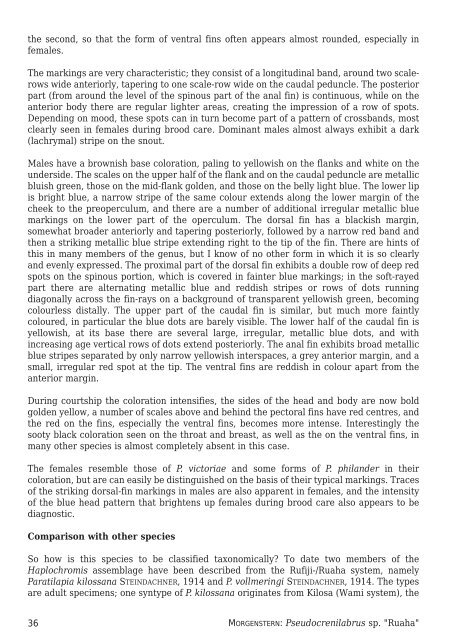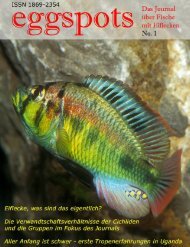Eggspots Elsewhere - Welt der Fische / World of Fishes
Eggspots Elsewhere - Welt der Fische / World of Fishes
Eggspots Elsewhere - Welt der Fische / World of Fishes
Create successful ePaper yourself
Turn your PDF publications into a flip-book with our unique Google optimized e-Paper software.
the second, so that the form <strong>of</strong> ventral fins <strong>of</strong>ten appears almost rounded, especially in<br />
females.<br />
The markings are very characteristic; they consist <strong>of</strong> a longitudinal band, around two scalerows<br />
wide anteriorly, tapering to one scale-row wide on the caudal peduncle. The posterior<br />
part (from around the level <strong>of</strong> the spinous part <strong>of</strong> the anal fin) is continuous, while on the<br />
anterior body there are regular lighter areas, creating the impression <strong>of</strong> a row <strong>of</strong> spots.<br />
Depending on mood, these spots can in turn become part <strong>of</strong> a pattern <strong>of</strong> crossbands, most<br />
clearly seen in females during brood care. Dominant males almost always exhibit a dark<br />
(lachrymal) stripe on the snout.<br />
Males have a brownish base coloration, paling to yellowish on the flanks and white on the<br />
un<strong>der</strong>side. The scales on the upper half <strong>of</strong> the flank and on the caudal peduncle are metallic<br />
bluish green, those on the mid-flank golden, and those on the belly light blue. The lower lip<br />
is bright blue, a narrow stripe <strong>of</strong> the same colour extends along the lower margin <strong>of</strong> the<br />
cheek to the preoperculum, and there are a number <strong>of</strong> additional irregular metallic blue<br />
markings on the lower part <strong>of</strong> the operculum. The dorsal fin has a blackish margin,<br />
somewhat broa<strong>der</strong> anteriorly and tapering posteriorly, followed by a narrow red band and<br />
then a striking metallic blue stripe extending right to the tip <strong>of</strong> the fin. There are hints <strong>of</strong><br />
this in many members <strong>of</strong> the genus, but I know <strong>of</strong> no other form in which it is so clearly<br />
and evenly expressed. The proximal part <strong>of</strong> the dorsal fin exhibits a double row <strong>of</strong> deep red<br />
spots on the spinous portion, which is covered in fainter blue markings; in the s<strong>of</strong>t-rayed<br />
part there are alternating metallic blue and reddish stripes or rows <strong>of</strong> dots running<br />
diagonally across the fin-rays on a background <strong>of</strong> transparent yellowish green, becoming<br />
colourless distally. The upper part <strong>of</strong> the caudal fin is similar, but much more faintly<br />
coloured, in particular the blue dots are barely visible. The lower half <strong>of</strong> the caudal fin is<br />
yellowish, at its base there are several large, irregular, metallic blue dots, and with<br />
increasing age vertical rows <strong>of</strong> dots extend posteriorly. The anal fin exhibits broad metallic<br />
blue stripes separated by only narrow yellowish interspaces, a grey anterior margin, and a<br />
small, irregular red spot at the tip. The ventral fins are reddish in colour apart from the<br />
anterior margin.<br />
During courtship the coloration intensifies, the sides <strong>of</strong> the head and body are now bold<br />
golden yellow, a number <strong>of</strong> scales above and behind the pectoral fins have red centres, and<br />
the red on the fins, especially the ventral fins, becomes more intense. Interestingly the<br />
sooty black coloration seen on the throat and breast, as well as the on the ventral fins, in<br />
many other species is almost completely absent in this case.<br />
The females resemble those <strong>of</strong> P. victoriae and some forms <strong>of</strong> P. philan<strong>der</strong> in their<br />
coloration, but are can easily be distinguished on the basis <strong>of</strong> their typical markings. Traces<br />
<strong>of</strong> the striking dorsal-fin markings in males are also apparent in females, and the intensity<br />
<strong>of</strong> the blue head pattern that brightens up females during brood care also appears to be<br />
diagnostic.<br />
Comparison with other species<br />
So how is this species to be classified taxonomically? To date two members <strong>of</strong> the<br />
Haplochromis assemblage have been described from the Rufiji-/Ruaha system, namely<br />
Paratilapia kilossana STEINDACHNER, 1914 and P. vollmeringi STEINDACHNER, 1914. The types<br />
are adult specimens; one syntype <strong>of</strong> P. kilossana originates from Kilosa (Wami system), the<br />
36 MORGENSTERN: Pseudocrenilabrus sp. "Ruaha"




